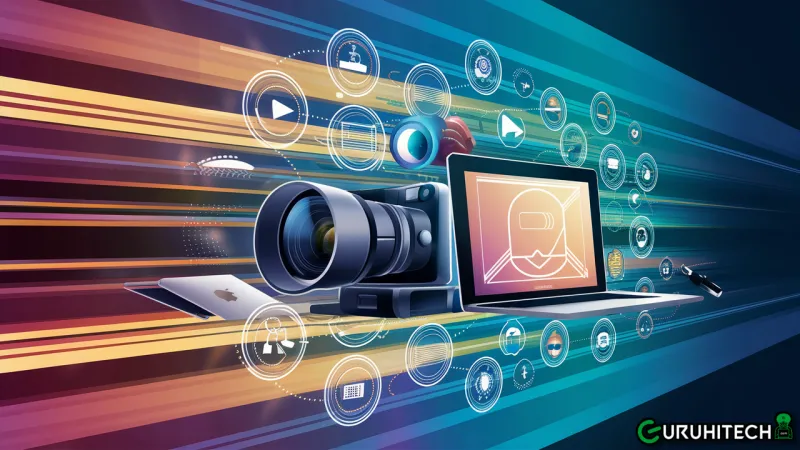Comprehensive Guide to eLearning Video Creation

In the rapidly evolving world of education technology, eLearning videos have become a cornerstone for knowledge dissemination, catering to diverse learning styles and accessibility needs. The success of platforms like Khan Academy and Coursera underscores the effectiveness of video-based learning.
Types of eLearning Videos
Exploring different formats of eLearning videos can cater to diverse learning styles and needs:
1. Explainer Videos: Typically animated, these videos break down complex topics into digestible pieces. They’re perfect for abstract concepts that benefit from visual aids.
2. Tutorial Videos: These are step-by-step procedural videos, often using screen captures to guide learners through software or processes.
3. Interactive Videos: These include quizzes and decision-making scenarios that engage learners actively, improving retention rates.
4. Story-Based Videos: Using narratives to teach lessons can enhance engagement by tapping into emotions, making the material more memorable.
Key Tools for eLearning Video Production
Selecting the right tools is crucial for creating professional and engaging eLearning videos. Here’s a breakdown of essential tools across different categories:
- Animation Tools: Software like Toonly and Adobe Animate help in crafting animated videos that are visually engaging.
- Video Editing Software: Tools like Adobe Premiere Pro and Final Cut Pro provide robust editing capabilities for high-quality video production.
- Screen Recording Tools: Camtasia and OBS Studio are excellent for tutorials, allowing educators to directly demonstrate tasks and operations.
- Interactive Video Creation: Platforms like H5P and Wirewax help create videos with embedded questions, clickable links, and other interactive elements for an engaging learning experience.

Best Practices in eLearning Video Creation
Creating impactful eLearning videos involves more than just conveying information; it’s about crafting an engaging learning experience. Here are several best practices to consider:
- Focus on Clear Learning Objectives: Start with clear goals. What should learners take away from the video? Structuring content around these objectives ensures relevance and clarity.
- Scripting and Storyboarding: Creating a script and storyboard before filming ensures that your content is organized and coherent. It also helps in visualizing the final product during the editing stages.
- Interactive and Collaborative Elements: Enhance engagement by incorporating interactive quizzes, collaborative tasks, and discussion prompts that encourage active learning and community interaction.
- Ensuring Content Security with Video Watermarking: Implementing video watermarking helps protect your courses from unauthorized distribution. By embedding a digital watermark, your videos will carry a mark of authenticity, aiding in misuse tracking and protecting your intellectual property.
- Feedback and Adaptation: Gather feedback through surveys or analytics to continuously improve video content, tailoring it to the needs and preferences of your audience.
- Engaging Content Creation: Content should be engaging and relevant. Using storytelling, humor, and relatable examples can help maintain viewer interest and facilitate learning.
- High-Quality Audio and Visuals: Invest in good quality audio equipment and test your visuals on different devices to ensure clarity and professionalism.
- Inclusion of Interactive Elements: Interactive elements such as quizzes, mid-video questions, and interactive summaries can significantly enhance learner engagement and retention.
- Use of Gamification: Incorporating game-like elements such as points, badges, and leaderboards can motivate learners and make the learning process more enjoyable.
Incorporating Current Trends and Technologies
As the digital landscape evolves, so does the field of eLearning. Staying abreast of the latest streaming stats and technologies is essential for creating videos that not only capture the attention of learners but also enhance their educational experience through innovative methods.
Here are a few key trends to consider:
- AR and VR in eLearning: Augmented Reality (AR) and Virtual Reality (VR) are redefining interactive learning by providing immersive experiences that are otherwise not possible in traditional learning environments.
- Mobile Learning: With the increasing use of smartphones, designing eLearning videos for mobile accessibility is crucial. This involves optimizing videos for smaller screens and ensuring that interactive elements are touch-friendly.
- Microlearning: This trend involves creating short, focused videos that are ideal for learners with limited time. These videos focus on one specific concept or skill and are usually under five minutes long.
- Artificial Intelligence (AI) in Personalization: AI can analyze learner data to offer personalized learning paths and content, enhancing the learning experience by addressing individual needs.
- Learning Analytics: Utilizing data collected from video interactions allows creators to refine content, understand engagement patterns, and improve educational outcomes.
- Social Learning: Integrating features that allow learners to interact, such as discussion forums or group projects, can mimic classroom dynamics and enhance learning through community.
- Accessibility Advances: Ensuring videos are accessible, including captions, audio descriptions, and compliance with accessibility standards, makes learning inclusive for all students.
Conclusion
eLearning video creation is an art that combines technology with creative storytelling to deliver compelling educational content. By understanding the different types of videos, utilizing the right tools, and following best practices, educators can create effective and engaging learning experiences.
Remember, the ultimate goal is to make learning accessible, enjoyable, and effective for all students, regardless of their backgrounds or learning styles.
Ti potrebbe interessare:
Segui guruhitech su:
- Google News: bit.ly/gurugooglenews
- Telegram: t.me/guruhitech
- Facebook: facebook.com/guruhitechweb
- Twitter: twitter.com/guruhitech1
- Instagram: instagram.com/guru_hi_tech/
- Threads: threads.net/@guru_hi_tech
- GETTR: gettr.com/user/guruhitech
- Rumble: rumble.com/user/guruhitech
- VKontakte: vk.com/guruhitech
- MeWe: mewe.com/i/guruhitech
- Skype: live:.cid.e496a29c3d8dfd2
- WhatsApp: bit.ly/whatsappguruhitech
Esprimi il tuo parere!
Ti è stato utile questo articolo? Lascia un commento nell’apposita sezione che trovi più in basso e se ti va, iscriviti alla newsletter.
Per qualsiasi domanda, informazione o assistenza nel mondo della tecnologia, puoi inviare una email all’indirizzo guruhitech@yahoo.com.
